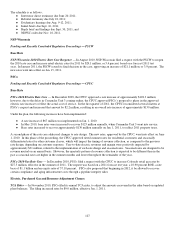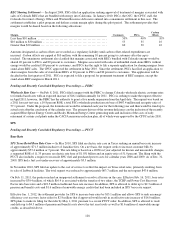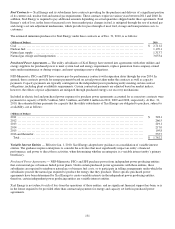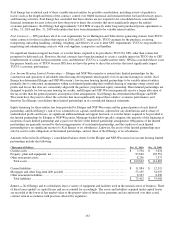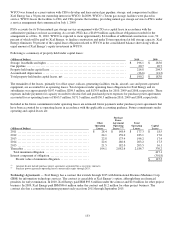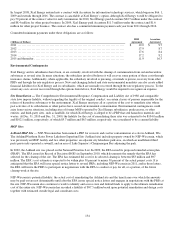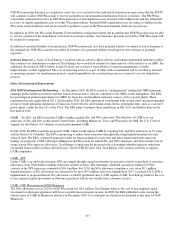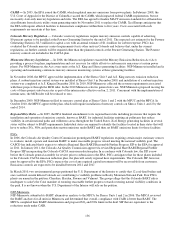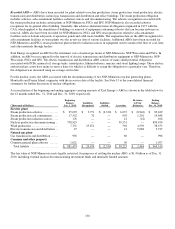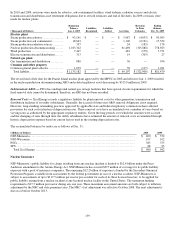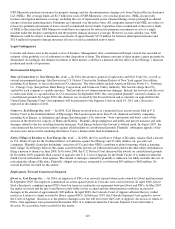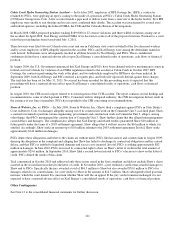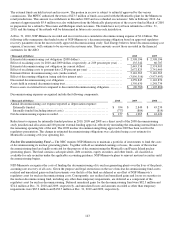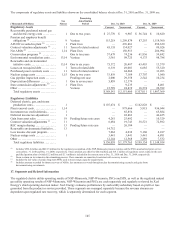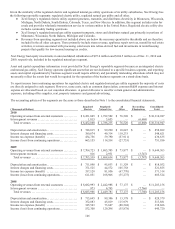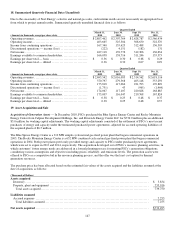Xcel Energy 2010 Annual Report Download - page 147
Download and view the complete annual report
Please find page 147 of the 2010 Xcel Energy annual report below. You can navigate through the pages in the report by either clicking on the pages listed below, or by using the keyword search tool below to find specific information within the annual report.137
In October 2009, the U.S. Department of the Interior certified that a portion of the visibility impairment in Voyageurs and Isle
Royale National Parks is reasonably attributable to emissions from NSP-Minnesota’s Sherco Units 1 and 2. The EPA is required
to make its own determination as to whether Sherco Units 1 and 2 cause or contribute to visibility impairment and, if so, whether
the level of controls proposed by MPCA is appropriate.
The MPCA determined that this certification does not alter the proposed SIP. The SIP proposes BART controls for the Sherco
generating facilities that are designed to improve visibility in the national parks, but does not require SCR on Units 1 and 2. The
MPCA concluded that the minor visibility benefits derived from SCR do not outweigh the substantial costs. In December 2009,
the MPCA Citizens Board approved the SIP, which has been submitted to the EPA for approval. Until the EPA takes final action
on the SIP, the total cost of compliance cannot be estimated with a reasonable degree of certainty.
Federal CWA — The federal CWA requires the EPA to regulate cooling water intake structures to assure that these structures
reflect the BTA for minimizing adverse environmental impacts. In 2004, the EPA published phase II of the rule, which applies to
existing cooling water intakes at steam-electric power plants. Several lawsuits were filed against the EPA challenging the phase II
rulemaking. In April 2009, the U.S. Supreme Court issued a decision concluding that the EPA can consider a cost benefit analysis
when establishing BTA. The decision gives the EPA the discretion to consider costs and benefits when it reconsiders its phase II
rules. Until the EPA fully responds, the rule’s compliance requirements and associated deadlines will remain unknown. As such,
it is not possible to provide an accurate estimate of the overall cost of this rulemaking at this time.
As part of NSP-Minnesota’s 2009 CWA permit renewal for the Black Dog plant, the MPCA required that the plant submit a plan
for compliance with the CWA. The compliance plan was submitted for MPCA review and approval in April 2010. The MPCA is
currently reviewing the proposal in consultation with the EPA. Xcel Energy anticipates a decision on the plan by the end of 2011.
Proposed Coal Ash Regulation — Xcel Energy’s operations generate hazardous wastes that are subject to the Federal Resource
Recovery and Conservation Act and comparable state laws that impose detailed requirements for handling, storage, treatment and
disposal of hazardous waste. In June 2010, the EPA published a proposed rule seeking comment on whether to regulate coal
combustion byproducts (often referred to as coal ash) as hazardous or nonhazardous waste. Coal ash is currently exempt from
hazardous waste regulation. If the EPA ultimately issues a final rule under which coal ash is regulated as hazardous waste, Xcel
Energy’s costs associated with the management and disposal of coal ash would significantly increase, and the beneficial reuse of
coal ash would be negatively impacted. Xcel Energy submitted comments to the EPA on Nov. 19, 2010 indicating its support of
the development of regulations to manage coal ash as a nonhazardous waste. The timing, scope and potential cost of any final rule
that might be implemented are not determinable at this time.
PSCo Notice of Violation (NOV) — In 2002, PSCo received an NOV from the EPA alleging violations of the New Source
Review (NSR) requirements of the CAA at the Comanche Station and Pawnee Station in Colorado. The NOV specifically alleges
that various maintenance, repair and replacement projects undertaken at the plants in the mid to late 1990s should have required a
permit under the NSR process. PSCo believes it has acted in full compliance with the CAA and NSR process. PSCo also believes
that the projects identified in the NOV fit within the routine maintenance, repair and replacement exemption contained within the
NSR regulations or are otherwise not subject to the NSR requirements. PSCo disagrees with the assertions contained in the NOV
and intends to vigorously defend its position.
Cunningham Compliance Order — In February 2010, SPS received a draft compliance order from the NMED for Cunningham
Station. In the draft order, NMED alleges that Cunningham exceeded its permit limits for NOx and failed to report these
exceedances as required by its permit. In September 2010, the NMED issued a final compliance order that contained a penalty of
$7.6 million. SPS requested an administrative hearing to contest the order. The administrative hearing has been scheduled for
April 2011.
Asset Retirement Obligations
Xcel Energy records future plant removal obligations as a liability at fair value with a corresponding increase to the carrying
values of the related long-lived assets in accordance with the applicable accounting guidance. This liability will be increased over
time by applying the interest method of accretion to the liability and the capitalized costs will be depreciated over the useful life
of the related long-lived assets. The recording of the obligation for regulated operations has no income statement impact due to
the deferral of the adjustments through the establishment of a regulatory asset.


